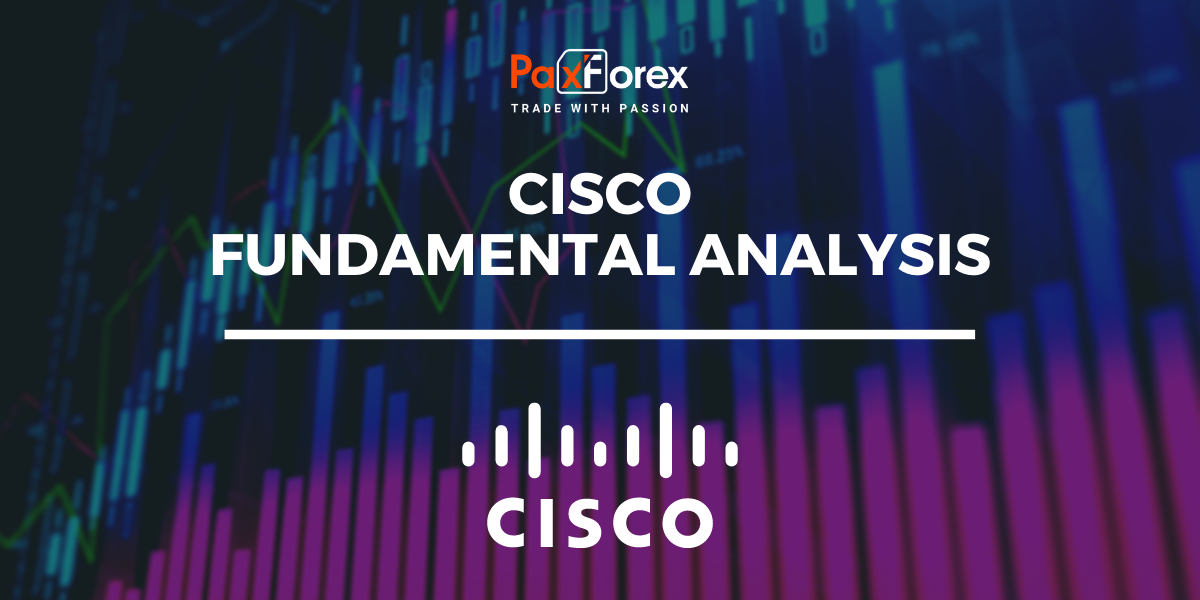
Source: PaxForex Premium Analytics Portal, Fundamental Insight
Over the past few years, Cisco Systems has been working to update its classic portfolio of services to better challenge the various fast-growing, innovative players it competes with a variety of markets. But because of the company's large scale, the transition has taken some time, and it contributed to the tech giant reporting a fifth consecutive quarter of declining revenue last week.
Recent successes have given Cisco a valuation in line with modest expectations. Does this mean the tech giant's stock is worth buying at this point? Or is this a trap for inattentive investors?
Cisco remains the dominant provider of networking solutions with its hardware switches and routers that carry traffic across networks. Over the past few years, it has developed and acquired businesses to create cross-selling opportunities with its core networking business. For example, it has become a major provider of cybersecurity solutions and offers unified communications solutions.
However, due to its aging hardware business, Cisco has shown a decline in revenue over the past five quarters. For the most recent quarter, revenue fell slightly to $11.96 billion, down from $12.01 billion a year ago.
In particular, the company's largest segment, infrastructure platforms (which includes legacy hardware products), fell 3% year over year to $6.4 billion.
On the other hand, Cisco's move to subscription-based software has led to some encouraging results. For example, Duo and Umbrella's cloud-based identity and remote work solutions saw cybersecurity grow 10% year over year to $822 million. And during the earnings discussion, CEO Chuck Robbins noted that WebEx's communications platform delivered double-digit percentage revenue growth with nearly 600 million users on average for the quarter.
In addition to these short-term results, Robbins provided, for the first time, additional information about the company's work with Web service providers (big cloud computing). He said the web-scale business became meaningful at 25 percent in the service provider segment after it performed "for the fifth consecutive quarter of very rapid order growth, increasing into the triple digits."
This development is a good indication of Cisco's long-term potential. Indeed, over the past few years, the company has failed to develop a competitive cloud computing offering compared to rival Arista Networks. As a result, the company's share of the high-speed data center switching market fell from 64.7 percent in 2015 to 43.7 percent in the first half of last year.
But Cisco is finally gaining traction in the cloud networking space with its new Cisco Silicon One offering, released in December 2019. With this new product, the company hasn't stayed away from the monolithic solutions that have been generating huge profits over the past few decades; it has finally broken down the hardware and software into parts to better meet the demand of cloud computing providers and service providers.
Thus, Cisco has finally shown that it can adapt and compete with agile and innovative smaller players, which bodes well for its future as it looks for ways to address the additional opportunities for rapid growth with new offerings.
For example, in October, the company announced a collaboration to offer an edge computing platform as a service for service providers to compete with fast-growing players such as Fastly and Cloudflare in content delivery networks and edge computing. These technologies represent strong growth potential because they help improve the response times of online services.
Also, Robbins said in the earnings call that the company is working on a full-scale surveillance platform so customers can monitor the full computing infrastructure and applications to improve performance and predict problems. That means Cisco will look to compete with fast-growing observability specialists such as Dynatrace and Datadog.
Looking ahead, management expects Cisco's revenue growth to be between 3.5% and 5.5% for the current quarter ending May 1, which looks solid. But compared to last year, the current quarter includes one extra week, which CFO Scott Herren says should contribute about 2% to 3% year-over-year revenue growth. And in the prior year, revenues were down 8% year-over-year, making the current quarter easily comparable.
Given Cisco's disappointing results and outlook, the stock is trading at a modest forward price-to-earnings ratio of 14.3.
Nevertheless, recent encouraging developments with web-scale cloud providers show that the tech giant is in a position to update its existing portfolio with competitive offerings in growth areas. Thus, since the market is not appreciating Cisco's growth opportunities, investors should consider buying the stock of this tech giant.

While the price is above 45.80, follow the recommendations below:
- Time frame: D1
- Recommendation: long position
- Entry point: 47.29
- Take Profit 1: 49.50
- Take Profit 2: 50.30
Alternative scenario:
If the level 45.80 is broken-down, follow the recommendations below:
- Time frame: D1
- Recommendation: short position
- Entry point: 45.80
- Take Profit 1: 44.30
- Take Profit 2: 43.40













